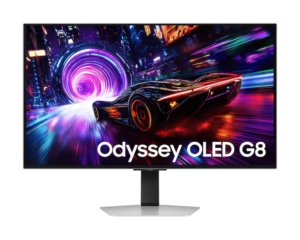Introduction
The ASUS ROG Swift OLED PG27UCDM brings together a premium mix of high resolution (4K), blistering refresh rate (240Hz), and OLED display tech in a relatively compact 27-inch frame. It promises sharp visuals, fast response, and the color fidelity and contrast we expect from OLED and QD-OLED panels.
In this review I’ll take you through real world use, pros & cons, comparisons with rivals, and whether this monitor is worth the price in late 2025.
Here’s what we’ll cover:
- Key specifications & design
- Gaming & motion clarity
- SDR, HDR, brightness and color performance
- Productivity / text clarity / uniformity
- Burn-in risk & long-term use
- Comparison with alternatives
- Verdict: who should buy, and who might be better served elsewhere
1. Key Specifications & Design
| Feature | Specification / Notes |
|---|---|
| Panel Type | 4th Gen QD-OLED @ROG+2PC Gamer+2 |
| Screen Size | ~26.5-inch (marketed as 27-inch) @ROG+1 |
| Resolution | 3840×2160 (4K UHD) @ROG+2PCWorld+2 |
| Refresh Rate | Up to 240Hz PC Gamer+2TechRadar+2 |
| Response Time (GtG) | ~0.03 ms @ROG+1 |
| Color / Gamut / Depth | 10-bit panel, wide gamut (DCI-P3 etc.) PCWorld+2@ROG+2 |
| SDR Brightness (full screen) | ~250 nits PC Gamer+2TechRadar+2 |
| HDR Peak Brightness | ~1,000 nits (small window / 3% area) PC Gamer+2PCWorld+2 |
| Connectivity | DisplayPort 2.1a (UHBR20), 2× HDMI 2.1, USB-C with ~90W PD, USB-A ports, etc. PCWorld+2@ROG+2 |
| Other Features | FreeSync Premium Pro, G-Sync compatibility, ELMB / black frame insertion (at lower refresh rates), Neo Proximity Sensor, OLED care/protection suite PCWorld+2NoobFeed+2 |
Design Notes:
- Good pixel density (~160-166 PPI) because 4K packed into 27-inch-class panel. Sharp UI / text rendering. PC Gamer+1
- Anti-reflection or matte coating is decent; helps under ambient lighting but doesn’t completely eliminate glare. PCWorld+1
- Stand is large, sturdy; bracket for third-party arms possible with caution. PCWorld
2. Gaming & Motion Performance
Responsiveness & Input Lag
- The monitor offers ultra-fast response time (0.03 ms GtG), which is practically among the best for consumer gaming monitors now. @ROG+2PC Gamer+2
- Input lag is low enough to not perceptibly hurt performance in fast-paced games. Rtings notes low system latency. RTINGS.com+1
Refresh / VRR & Motion Clarity
- 240Hz gives very smooth frame transitions, especially in competitive or fast-motion gaming. PC Gamer+2PCWorld+2
- Supports adaptive sync: both FreeSync Premium Pro and NVIDIA G-Sync compatibility. Tear-free, smooth visuals. @ROG+2PCWorld+2
- At lower refresh rates (e.g. 120Hz), ELMB (black frame insertion) is supported and helps with motion clarity. Trade-off: brightness drops. PCWorld+1
Flicker & Consistency
- Some reviewers noted VRR flicker (especially when frame rates vary) being more noticeable than expected. The anti-flicker features help, but do not eliminate completely. RTINGS.com+1
- Viewing angles are excellent; color / brightness shift when off-angle is minimal. Tom’s Hardware
3. SDR, HDR, Brightness & Color Performance
SDR Performance
- SDR full-screen brightness ~250 nits is adequate for many indoor/gaming setups; not overwhelming, so under very bright ambient lighting the image may be washed. PC Gamer+2PCWorld+2
- Color accuracy and gamut are strong: pretty faithful out of the box in sRGB / DCI-P3 modes. Good for content creators or color-sensitive use. PCWorld+1
HDR Performance
- Peak brightness hits ~1,000 nits for small window / highlights, which delivers impressive HDR highlights. PC Gamer+1
- Contrast (OLED) is “true black” — excellent for dark scenes, cinematic content, immersive gaming. RTINGS.com+1
- Supports HDR10 & Dolby Vision. True Black HDR certification (DisplayHDR True Black 400) adds to credibility. PCWorld+1
Weaknesses under Bright Light / Large Highlights
- HDR / SDR brightness for full screen is limited; large full-bright scenes or strong ambient light will reduce contrast. Blacks may look less deep under such conditions. RTINGS.com+1
- Reflections or glare may become more of an issue in bright rooms due to the finish. TechRadar
4. Productivity, Text Clarity & Uniformity
- Text rendering is very crisp thanks to high pixel density (~160-166 PPI). Lesser fringing of text compared to some older OLEDs. PC Gamer
- Uniformity of screen is very good; dark uniformity, minimal hot-spots or anomalies. Tom’s Hardware
- Color uniformity also strong; for creative usage (photo/video editing) this is a plus.
5. Burn-in Risk & Long-Term Use
- ASUS includes OLED Care features: pixel shifting, screen saver applied on static content, auto detection of logos, etc. NoobFeed+1
- Neo Proximity Sensor: it detects when you leave and can transition display to black image to protect panel. Good in theory; some users report quirks. @ROG+1
- Warranty and burn-in protection should be checked per region; ASUS seems mindful of component lifespan with the 4th gen panel.
6. Drawbacks & Trade-offs
- High price. The cost is premium, as expected for bleeding-edge specs. PC Gamer+2PCWorld+2
- SDR full screen brightness limitation in bright-room / daylight usage.
- Slight VRR flickers as mentioned. Real for some users, especially with lower FPS.
- Stand size / design may be bulky for some desks.
- The Neo Proximity Sensor, while innovative, has mixed feedback: sometimes triggers unexpectedly or may need calibration / firmware tweaks. Reddit
7. Comparison with Alternatives
| Rival / Category | What PG27UCDM does better | Where rivals might beat it |
|---|---|---|
| Other 27-inch 4K QD-OLEDs (e.g. MSI, Samsung) | Often similar specs; PG27UCDM has strong extras (USB-C 90W PD, ELMB mode, proximity sensor) PCWorld+1 | Rivals may offer slightly cheaper pricing or slightly higher brightness in SDR full screen in some cases |
| Larger OLED models (32-inch etc.) | PG27UCDM gives sharper pixel density, less space use, easier to drive at high fps | Larger screens give more immersive size; sometimes more brightness or features for media consumption |
| High-end IPS or Mini-LED LCDs | OLED has superior contrast, blacks, motion clarity; PG27UCDM offers excellent color accuracy too | IPS / Mini-LED may offer higher SDR brightness in large and bright lighting, no burn-in risk |
8. Verdict & Who Should Buy
Strengths
- Superb image quality: OLED blacks + sharp detail due to high PPI.
- Excellent motion clarity; 240Hz + low response times make it well suited for fast gaming.
- Rich feature set: HDR (10 & Dolby Vision), connectivity (DP 2.1, HDMI 2.1, USB-C PD), black frame insertion, proximity sensor, etc.
- OLED care features help mitigate long term issues.
Weaknesses
- Price is high — only justified if you use features fully.
- Limitations in full-screen SDR brightness and under strong ambient lighting.
- VRR flicker and sensor behavior might need firmware updates / tuning.
Ideal Buyer
- Competitive and AAA gamers who want both visual fidelity and speed.
- Content creators / multimedia users who care about accurate color and HDR.
- Users who have controlled lighting or gaming setup and plan to use features like proximity sensor / OLED care.
Not Ideal If
- You work mostly in bright environments or near windows & strong light.
- You have a tight budget where you can’t justify the premium.
- You prioritize size over sheer sharpness; might prefer larger panels.
Overall Rating Estimate: ~ 4.6 / 5 — for those who can afford it and will make use of its strengths, it’s among the best 27-inch 4K OLED gaming monitors in 2025.



